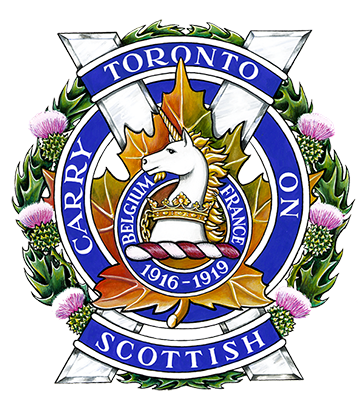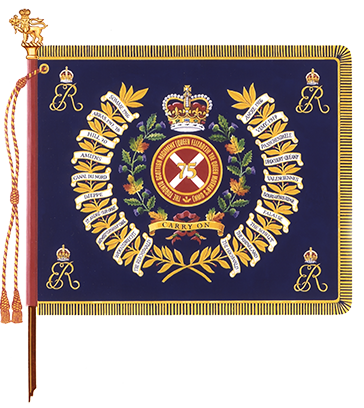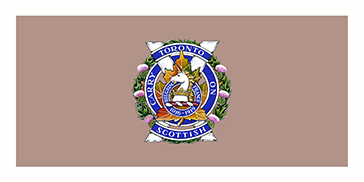The Toronto Scottish Regiment (Queen Elizabeth The Queen Mother’s Own)
The official lineage of The Toronto Scottish Regiment (Queen Elizabeth The Queen Mother’s Own) infantry regiment.

Colonel-in-Chief: His Majesty King Charles III, King of Canada
Badge
Description
Upon a wreath of thistles proper a saltire Argent charged with an autumnal maple leaf proper both interlacing an annulus Azure edged and inscribed CARRY ON in letters Argent, the leaf charged with a like annulus inscribed BELGIUM FRANCE 1916-1919, overall on a torse Argent and Gules a unicorn's head Argent armed crined and gorged with a coronet chained Or, the upper and lower arms of the saltire set with two scrolls Azure edged and inscribed TORONTO in chief and SCOTTISH in base Argent.
Symbolism
The maple leaf represents service to Canada. The thistles (the national flower of Scotland) and the cross of St. Andrew (the patron saint of Scotland) are common devices among badges of highland infantry, and the overall shape of the badge is similar to The London Scottish, the regiment's first allied regiment. The unicorn is taken from the badges of the 75th "Overseas" Battalion and The Mississauga Horse in recognition of the regiment's historical connection with these units. The words "BELGIUM", "FRANCE" and the dates "1916-1919" commemorate the service of the regiment's perpetuated units during the First World War. "TORONTO SCOTTISH" is a form of the regimental title and "CARRY ON" is the motto of the regiment.
Motto
CARRY ON
March
"Blue Bonnets Over the Border"
Alliance
British Army
The Royal Regiment of Scotland and The London Regiment
Regimental colour

Camp flag

Battle honours
The First World War
SOMME, 1916; Ancre Heights; Ancre, 1916; ARRAS, 1917, '18; Vimy, 1917; HILL 70; YPRES, 1917; Passchendaele; AMIENS; Scarpe, 1918; Drocourt-Quéant; HINDENBURG LINE: Canal du Nord; VALENCIENNES; SAMBRE; FRANCE AND FLANDERS, 1916-18.
The Second World War
Dieppe; BOURGUÉBUS RIDGE; St. André-sur-Orne; Verrières Ridge-Tilly-la-Campagne; FALAISE; Falaise Road; Clair Tizon; Dunkirk, 1944; Antwerp-Turnhout Canal; THE SCHELDT; Woensdrecht; South Beveland; THE RHINELAND; The Reichswald; Goch-Calcar Road; The Hochwald; Xanten; Twente Canal; Groningen; Oldenburg; NORTH-WEST EUROPE, 1942, 1944-1945.
South-West Asia
AFGHANISTAN
Lineage
This Reserve Force regiment originated in Toronto, Ontario on 1 May 1920, when 'The Mississauga Regiment' was authorized to be formed.Footnote 1 It was redesignated 'The Toronto Scottish Regiment' on 1 September 1921.Footnote 2 On 15 December 1936, it was amalgamated with 'B Company' and 'C Company' of the '1st Machine Gun Battalion, CMGC' and redesignated 'The Toronto Scottish Regiment (Machine Gun)'.Footnote 3 It was redesignated: '2nd Battalion, The Toronto Scottish Regiment (Machine Gun)' on 7 November 1940;Footnote 4 'The Toronto Scottish Regiment' on 19 June 1947;Footnote 5 and 'The Toronto Scottish Regiment (Queen Elizabeth The Queen Mother's Own)' on 19 October 2000.Footnote 6
Notes:
Upon organization as The Mississauga Regiment on 1 May 1920 (see above), it was organized as a two battalion regiment with the 1st Battalion (75th Battalion, CEF) on the Non Permanent Active Militia order of battle and the 2nd Battalion (84th Battalion, CEF) on the Reserve order of battle. The reserve unit was disbanded on 14 December 1936 (GO 3/37).
The Toronto Scottish Regiment was disbanded for the purpose of amalgamation on 14 December 1936 and reorganized the next day (GO 189/36). This change was administrative and does not affect the lineage of the regiment.
The perpetuation of the 1st Machine Gun Battalion, CMGC (1919-1936) was assigned to The Irish Regiment of Canada (Machine Gun) (GO 149/37).
Perpetuations
'75th' and '84th "Overseas" Battalion(s), CEF'
Headquarters Location
Mississauga, Ontario
Operational history
The First World War
The 75th Battalion, which was authorized on 10 July 1915 as the '75th "Overseas" Battalion, CEF',Footnote 7 embarked for Great Britain on 29 March 1916.Footnote 8 It disembarked in France on 12 August 1916,Footnote 9 where it fought as part of the 11th Infantry Brigade, 4th Canadian Division in France and Flanders until the end of the war.Footnote 10 The battalion was disbanded on 15 September 1920.Footnote 11
The 84th Battalion, which was authorized on 10 July 1915 as the '84th "Overseas" Battalion, CEF',Footnote 12 embarked for Great Britain on 18 June 1916.Footnote 13 On 30 June 1916, its personnel were absorbed by the '73rd "Overseas" Battalion, CEF', 75th "Overseas" Battalion, CEF' and other units of the 4th Canadian Division, to provide reinforcements for the Canadian Corps in the field.Footnote 14 The battalion was disbanded on 11 April 1918.Footnote 15
The Second World War
The regiment mobilized 'The Toronto Scottish Regiment (Machine Gun), CASF' for active service on 1 September 1939.Footnote 16 It was redesignated: '1st Battalion, The Toronto Scottish Regiment (Machine Gun), CASF' on 7 November 1940;Footnote 17 '2nd Infantry Division Support Battalion (The Toronto Scottish Regiment), CIC, CASF' on 1 May 1943;Footnote 18 and '1st Battalion, The Toronto Scottish Regiment (Machine Gun), CIC, CASF' on 24 February 1944.Footnote 19 On 7 December 1939, it embarked for Great Britain.Footnote 20 The battalion took part in the raid on Dieppe on 19 August 1942.Footnote 21 It landed again in France on 6 and 7 July 1944, as part of the 2nd Infantry Division, and it continued to fight in North-West Europe until the end of the war.Footnote 22 The overseas battalion was disbanded on 31 December 1945.Footnote 23
South-West Asia
From 2002 to 2014, the Toronto Scottish Regiment (Queen Elizabeth The Queen Mother’s Own) augmented various CAF units deployed to Afghanistan.Footnote 24